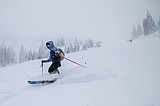Wildlife officials hopeful about decline of chronic wasting disease in Libby
KATE HESTON | Hagadone News Network | UPDATED 2 years, 2 months AGO
Kate Heston covers politics and natural resources for the Daily Inter Lake. She is a graduate of the University of Iowa's journalism program, previously worked as photo editor at the Daily Iowan and was a News21 fellow in Phoenix. She can be reached at [email protected] or 406-758-4459. | October 20, 2023 12:00 AM
The prevalence of chronic wasting disease in Libby has continued to decrease since the outbreak was detected in 2019, according to state wildlife officials.
Chronic wasting disease, or CWD, is a fatal, neurological illness that occurs in members of the deer family, including animals native to Montana like white-tailed deer, mule deer, elk and moose.
“There is no cure for it, no treatment for it, and at least for now all of our information shows that it is fatal,” said Neil Anderson, the wildlife manager for Montana Fish, Wildlife and Parks Region 1.
First discovered in 1967 in a Colorado research facility, it has since been detected in at least 23 states, two Canadian provinces and South Korea, according to the U.S. Geological Survey.
Montana Fish, Wildlife and Parks began active surveillance in the state in 1998 and found no cases until 2017. Now the agency is tracking cases along the Canadian border in Eastern Montana, as well as hot spots near Dillon and around the Crow Indian Reservation.
The disease is contagious, spread through animal-to-animal contact and indirectly by coming in contact with the saliva, urine, feces or carcases of animals that are affected. The more infected animals on the ground, the more environmental contamination as well.
“One of our biggest concerns is just the overall health of the population,” Anderson said.
When officials first detected the disease in Libby, they initially saw 13% prevalence among the population, Anderson said. The majority of those infected were white-tailed deer. Currently, the prevalence is around 8% or 9%.
It was the first time the state detected the disease within an urban area in Montana, according to the Libby CWD Summary Report from 2022.
“Libby is unique,” said Emily Almberg, a wildlife disease biologist with Montana Fish, Wildlife and Parks.
While the hopes of eradicating the disease are very low, Almberg said, there is a statewide effort to limit the spread — a concern shared by hunters and scientists alike.
“It reduces game numbers out there and the big concern is just that people will be reluctant to hunt knowing that an animal they get may be infected,” said Jim Vashro, a hunter and president of Flathead Wildlife, Inc.
According to Vashro, the best thing Montana Fish, Wildlife and Parks can do is contain it.
CONTAINMENT IS one of the agency’s biggest concerns, according to Anderson. It is important to reduce the density of deer within city limits to slow and reduce the spread of the disease.
“It’s a really tough thing to try to get a handle on,” said Anderson.
In late 2021, Libby’s City Council passed Resolution 1979, creating a municipal deer management plan. The document includes removing sickly and aggressive deer, preventing illegal feeding of deer, increasing public education and encouraging proper disposal of deer carcasses.
Libby has a CWD Management Zone. The goal, according to the state wildlife agency, is to collect enough samples within the zone to estimate, and then reduce, the prevalence of the disease.
“Right now in Libby, there is no indication that the prevalence is getting higher or spreading out,” Anderson said.
While there is no evidence that the disease is transferable to humans, it is not recommended to eat infected meat. In 2019, hunters were required to submit samples for elk and moose. Beginning in 2020, hunters no longer need to submit samples, but all hunters in Region 1 are encouraged to test any harvested animal.
It is important for hunters to continue to submit samples, Anderson said. The agency needs the information to monitor the disease since there is no live animal test. Samples can be dropped off for free at any sampling station.
Samples can be mailed to the Wildlife Health Lab in Bozeman or taken to an agency regional office. Results take around two weeks to return.
The state wildlife agency is offering free instructional workshops in the area for hunters to learn how to collect samples from deer, elk and moose. Staff will be available at both events to provide information and answer questions.
A workshop will be held Oct. 23 at the Montana Fish, Wildlife and Parks office at 490 N. Meridian Road in Kalispell from 6 p.m. to 7 p.m.
To participate, hunters should bring a deer, elk or moose carcass or head with 2-4 inches of neck remaining below the jaw from a recent harvest, if they have one. There will be both demonstrations as well as opportunities for hunters to do it themselves.
To find other sampling station locations and hours, visit https://fwp.mt.gov/cwd.
Reporter Kate Heston can be reached at [email protected] or 758-4459.
ARTICLES BY KATE HESTON

Veteran-owned mobile boat repair service anchors down in the Flathead Valley
The Kramers launched Flathead Mobile Marine to use their skills — they have decades of experience performing routine maintenance checks on a variety of boats as well as working with engines and electrical systems — and help boaters in the community.

With ski season near, resort reaches deal with staff
After 18 months of negotiations, Whitefish Mountain Resort executives and the resort’s ski patrol union are finalizing a one-year contract for the upcoming season.

Trapped in a car wreck, Woods Bay woman credits teens with saving her life
Driving home from a quilting event in Bigfork in September of last year, Carol Martin remembered that the sky was clear, the sun was shining, and she had a headache.

